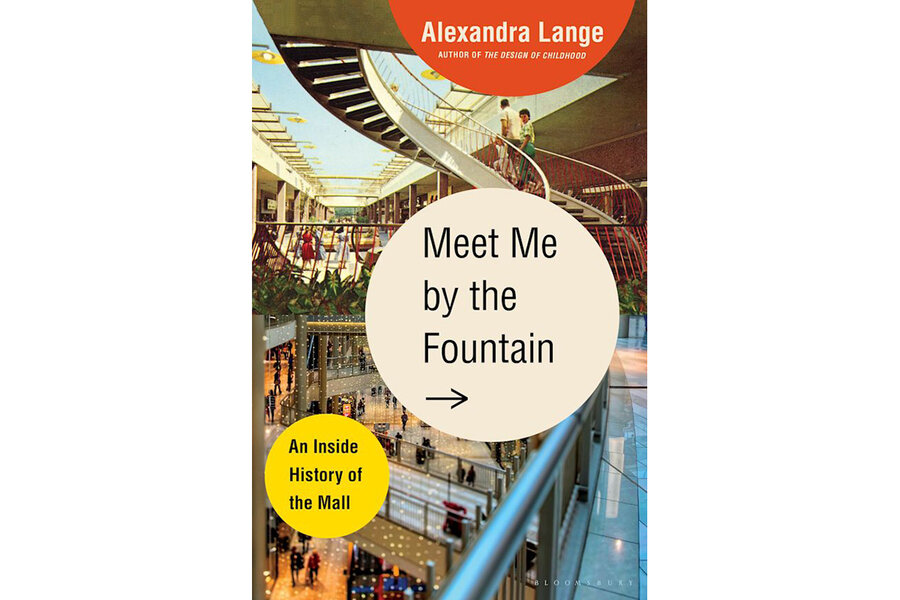The heyday of shopping malls is gone, but far from forgotten
Loading...
In recent years, so-called dead malls have attracted photographers intrigued by seeing the one-time symbols of suburban prosperity emptied of all life, abandoned and decaying. With as many as a quarter of the nation’s 1,000 remaining shopping malls predicted to go under in the next five years, these documentarians will continue to have plenty of material.
Given the mall’s fading prospects, one might expect Alexandra Lange’s “Meet Me by the Fountain: An Inside History of the Mall” to focus squarely on the past. But to her credit, the author and architecture critic orients her sharp and perceptive cultural history toward the future, exploring ways the much-maligned mall can be reimagined and repurposed.
At the outset, Lange notes that the mall is “potentially a little bit embarrassing as the object of serious study.” But as she did in her previous book, “The Design of Childhood” – which examines children’s material environment, including toys, playgrounds, and classrooms – Lange ably makes the case for the significance of her subject. Malls grew up hand in hand with America’s suburban neighborhoods, and their history is equally ripe for the analyses of race, class, and gender that have deepened our understanding of the development of postwar suburbia. Lange believes malls are important for another reason: She argues that they fulfill a basic human need to share public space with other people.
Lange covers the design of malls, starting with the work of early innovator Victor Gruen, the Austrian architect who in the mid-1950s created both the first suburban open-air shopping center in Southfield, Michigan, and the first enclosed shopping mall in Edina, Minnesota. In a blueprint that would influence the development of malls across the country, Edina’s Southdale Mall featured two department stores serving as anchors on opposite ends, a central atrium with a glass-paneled roof, and, of course, thousands of parking spaces ringing the entire structure. Southdale’s early ads read, “Every day will be a perfect shopping day,” a nod to the importance of the spread of air conditioning to the success of the climate-controlled indoor mall.
The author demonstrates, however, that early developers of malls believed that providing a “perfect” experience to the coveted demographic of white, middle-class, female shoppers also meant excluding many others. Racially restrictive covenants and discriminatory loan practices already prohibited Black families from buying homes in the suburbs; malls were designed to be convenient to suburban car owners, not urban residents relying on public transit. Malls, born of the desire to remove shopping from the downtown districts that whites had forsaken, eventually embraced the city again, in the form of developer James Rouse’s festival marketplaces of the 1970s and 1980s (Boston’s Faneuil Hall, Baltimore’s Harborplace) and, later, pedestrianized city streets.
One of the most interesting tensions of the book involves the way malls have both offered and restricted freedom. Teenagers in particular cherished the autonomy they could experience there. As Lange observes, “For children growing up in car-dominated landscapes, the mall offered the first opportunity for independent movement, the first opportunity for independent consumption, and the first opportunity to make their own money, through entry-level retail jobs.” But many malls responded by overpolicing and surveilling teens, particularly teens of color, with some instituting curfews and policies prohibiting teenagers from gathering in groups.
Teenagers haven’t been the only people to turn the mall into a coveted social space. Lange also charts the rise of the “mall walkers,” groups of senior citizens who meet in shopping malls to walk for exercise, taking advantage of the controlled climate, the smooth floors, and the easy availability of restrooms and benches.
“Meet Me by the Fountain” recounts the familiar reasons for the mall’s demise – the rise of online shopping, the fading popularity of department stores, and the proliferation of big-box stores. The Covid-19 pandemic, of course, heightened the challenges malls already faced.
But given that these hulking structures exist, what should become of them as they go out of business, beyond providing inspiration for spooky photography? Lange suggests other ways to take advantage of abandoned malls, including creating mixed-use spaces that incorporate housing, shopping, and medical offices. She cites former malls turned into ethnic food halls as well as a community college in Austin, Texas, that took over a mall that had gone into foreclosure.
Just as Lange reflects on the joy she found at the local North Carolina mall of her childhood, many readers will likely reminisce about the malls where they once shopped or worked or simply hung out. But Lange eschews nostalgia in favor of bold ideas that focus on community and sustainability. Her potentially embarrassing topic pays off as she demonstrates that “both a defense of and a new life for the mall are possible.”








